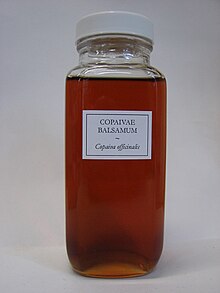Kopaiva balm
Kopaivabalsam also Jesuiterbalsam ( Latin Balsamum Copaivae , also called) "Copaiba oil" and "Copahu" was a balm of Drogistikhandels the 19th century. It comes from different species of the genus Copaifera , which are native to South America and the West Indies , as well as from Daniellia oliveri , Daniellia thurifera (African Kobaivabalsambaum, also called Illurinbalsam) and also from Sindora spp. ( Sindora wallichii ), Eperua spp. ( Eperua oleifera ). A similar balm, the Hardwickia balm, comes from Prioria pinnata (Syn .: Kingiodendron pinnatum ) and Hardwickia binata .
If the balm hardens, recent copal is produced .
The South American varieties were considered the better ones and could only be used for medicinal purposes; the West Indian Kopaiva balsam was only used for technical purposes and is a thick, cloudy, turpentine- like smelling liquid. Good South American copaiva balsam had to be completely clear, light yellow to golden yellow and rather thick, it had a peculiar, aromatic smell and a scratchy bitter taste. Para - or Marana balm , Maracaibo - or Venezuelan balm and Angostura balm , which came on the market as a subspecies of the latter, were available as special varieties of South American goods . The Parasort was a little lighter yellow and thinner than the Maracaibo variety . Adulterations of the Kopaiva balsam were not uncommon, especially with fatty oils, resins, turpentine and Gurjun balsam . The authenticity of the balsam could easily be recognized by the behavior of the Kanna starch granules (Arrow-Root from Queensland ) under the microscope , which, when placed in real balsam, became invisible, but revealed their contours when they were adulterated. Furthermore, an African Kopaiva balm (also called "Illurin balm") was on the market. According to Tschirch, Prioria mannii (Syn .: Hardwickia mannii or Oxystigma mannii ) is named for plant origin . The deliveries came from the Niger region in West Africa .
The essential components of the copaiva balsam are a resinous acid, copaiva acid , and an essential oil. The copaivic acid ( Acidum copaivicum ) was once used medicinally, it was a snow-white, crystalline powder, which was usually obtained from the Gurjun balm, which contained more of it than the Kopaiva balm. The balm and acid were exempt from duty .
Technically it is used, among other things, for the extraction of caryophyllene and cadinene , as well as for the production of soaps, lacquers and varnishes .
A colorless to slightly yellowish and pungent smelling essential oil, Kopaiva (balsam) oil (Copaivae aetheroleum) can be obtained from the balm (Aetheroleum copaivae, Oleum (balsami) copaivae). It has been widely used to adulterate other essential oils.
literature
- W. Blaschek, R. Hänsel among others: Hager's Handbook of Pharmaceutical Practice. Volume 2: Drugs A – K , Springer, 1998, ISBN 3-540-61618-7 , pp. 421–428 limited preview in the Google book search.
Web links
- Entry to Kopaivabalsam at Vetpharm, accessed on 21 November 2011th
Individual evidence
- ↑ N. M. Gomes, C. M. Rezende, S. P. Fontes, M. E. Matheus, P. D. Fernandes: Antinociceptive activity of Amazonian Copaiba oils. In: Journal of ethnopharmacology . Volume 109, Number 3, February 2007, pp. 486-492, doi: 10.1016 / j.jep.2006.08.018 , PMID 17029841 .
- ^ Jean Avalon: Deux mots sur l'histoire du Santal et du Copahu. In: Aesculape 18, 1928, pp. 92-94.
- ↑ Felix Bachmair: Antimicrobial effect of selected resins on airborne germs. Diploma thesis, University of Vienna, 2013, pp. 29–32, online (PDF; 2.9 MB), at othes.univie.ac.at, accessed on January 3, 2017.
- ↑ Alexander Tschirch: The resins and the resin containers with inclusion of the milk juices. Leipzig 1906, p. 786, archive.org .
- ↑ Kopaiva balsam. In: Lexicon of Biology. Spektrum Verlag, accessed on August 25, 2017 .
